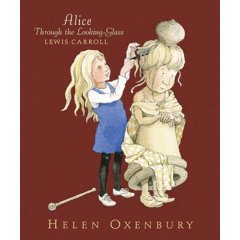
Okay . . . so I aspire to be like Alice in Wonderland. Let me clarify this statement, so you don't think that I am from the sixties acid generation. When I read Lewis Carroll's "Alice in Wonderland" and "Alice Through the Looking Glass", I see Alice as a curious child on an imaginative adventure, meeting a cast of whimsical characters along the way. That is MY ALICE! Well . . . I just finished reading a bazaar review stating that some view "Alice in Wonderland" as a metaphor for the bodily mutations of female puberty, or as a covert paean to hallucinogenic drug abuse! I THINK NOT!. For me, both books are fascinating timeless literature of a child's sense of wonderment. So there Grace Slick! Actually I love Jefferson Airplane. Anyways, the latest edition, of "Alice Through the Looking Glass", illustrated by Helen Oxenbury, has beautiful sepia-toned illustrations and full-color paintings! They read at a third grade level, perfect for my two girls ages 8 & 11. I fully recommend re-reading these latest editions with your children. View it on my online store at http://estore.websitepros.com/805672/Detail.bok?no=115 . P.S. I posted some editorial reviews, under comments.


2 comments:
Review from School Library Journal: Grade 2 Up–In this delightful companion to Oxenbury's illustrated version of Carroll's Alice's Adventures in Wonderland (Candlewick, 1999), Alice now wears black tights and a white long-sleeved shirt to suit the winter setting (Without, the frost, the blinding snow,/The storm-wind's moody madness–/Within, the firelight's ruddy glow,/And childhood's nest of gladness). Leaving the cozy room behind, she steps through the looking glass and into a world depicted in warm watercolors, sepia-toned illustrations, and line drawings. Not a word of the original tale has been altered. The artwork echoes the whimsy of the language, clearly showing Alice's amusement at the antics of Tweedledum and Tweedledee, her frustration at the impossibility of slicing a Looking-glass cake, her affection for the gentle White Knight, and her exasperation when both the White and the Red Queen fall asleep snuggled against her. The large font and numerous illustrations, including many single- and double-page paintings, make this edition inviting for reading aloud or alone. The artwork has an engaging openness to it, and Alice comes across as a real child, making it easy for readers to imagine themselves exploring the wonders of this make-believe realm.–Joy Fleishhacker,School Library Journal
Copyright © Reed Business Information, a division of Reed Elsevier Inc. All rights reserved.
Review From Booklist: *Starred Review Gr. 4-7. Oxenbury won the Kate Greenaway Medal for her illustrated edition of Alice's Adventures in Wonderland (1999), and she continues her splendid interpretation with this companion title. Once again, Oxenbury contributes small, black-and-white drawings and full-page watercolors, and her subtle use of color and shade adds layers of meaning to the story. The kings and queens of the chessboard seem vibrantly alive, all grand gestures and magnificently haughty expressions, yet Oxenbury reinforces the notion that they are still only game pieces by painting them in monochromatic shades of either red or white (indicating their home side of the chess board), unlike other characters, such as the charmingly rendered Humpty Dumpty, who appear in vivid full color. In many images, the sturdy line sketches appear within richly dimensional watercolor worlds, and the juxtaposition of both in the same scene, like the coloring of the chess pieces, calls attention to Carroll's own playful jumble of solid, real-world elements (chess pieces, kittens, Alice herself) and delicious, wholly imagined fantasy. But children certainly won't need to look for deeper significance in the pictures to enjoy the wild adventures. Young and old alike will easily embrace Oxenbury's Alice, who seems both old-fashioned and modern, and comfortable in worlds on both sides of the mirror. Gillian Engberg
Copyright © American Library Association. All rights reserved
Post a Comment